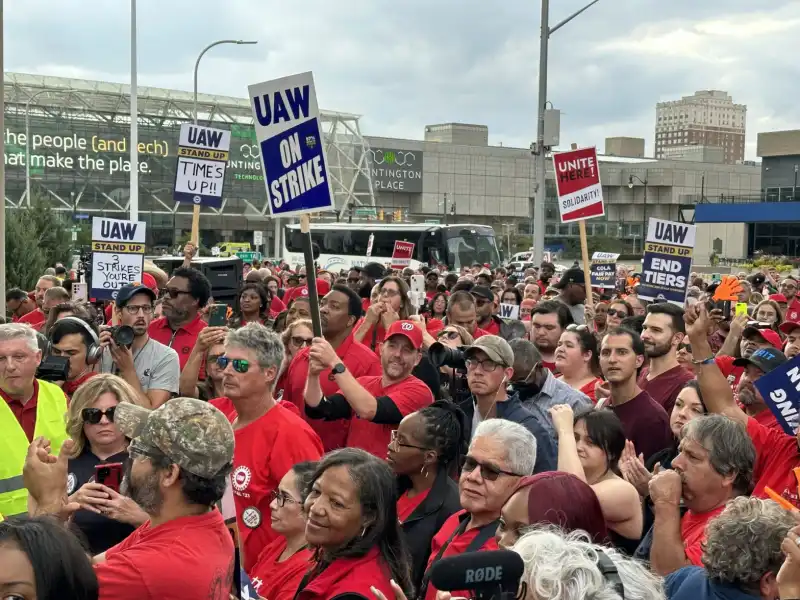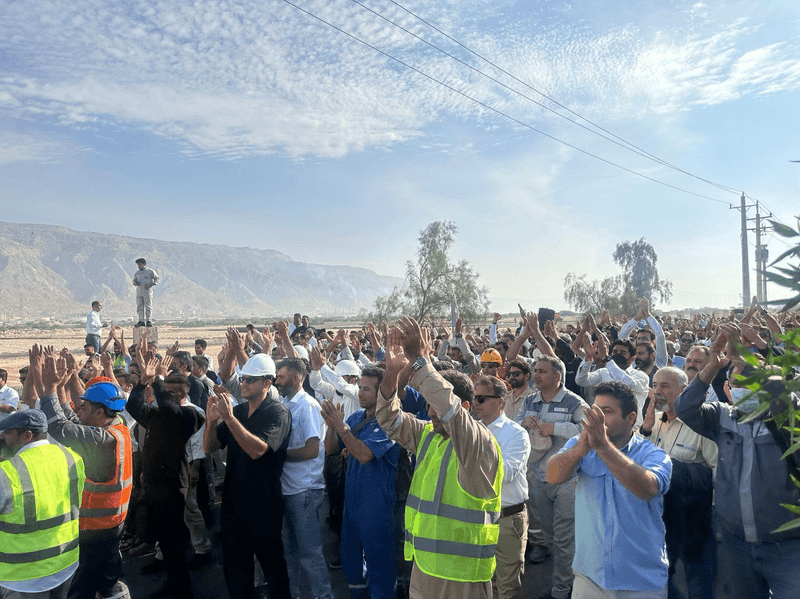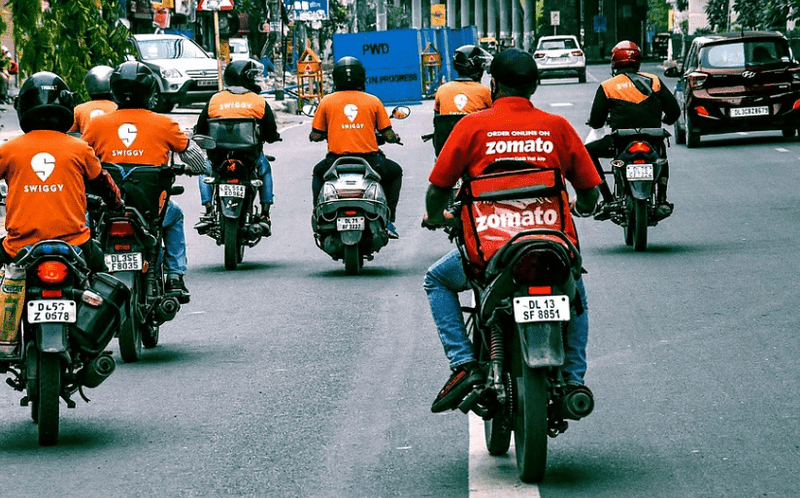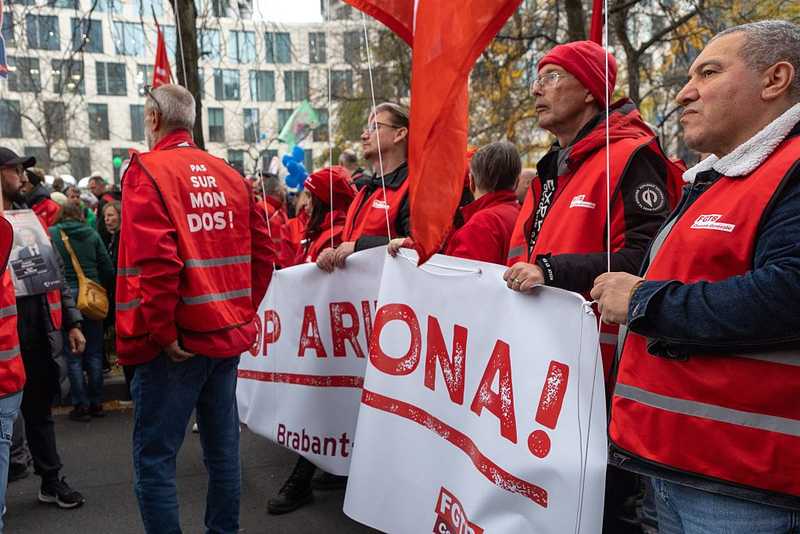
At 11PM on September 14, just before midnight, a crowd of United Auto Workers members and their supporters began amassing across the street from Ford’s Michigan Assembly Plant in Wayne. A stream of honking cars had already begun exiting the factory gates. Outside the UAW Local 900 union hall, which sits adjacent to the assembly plant, white shuttle vans were humming at the ready—and before long, the picket lines were up.
At midnight, it was official: for the first time in the union’s history, UAW workers at each of the Big Three automakers—Ford, GM, and Stellantis (formerly Chrysler)—were striking simultaneously. The union’s new strategy of “stand up” strikes, whereby select locals are gradually called out to strike at their plants, had gone into effect. Two hours prior, at 10pm on a Facebook livestream, UAW President Shawn Fain had announced the union’s first targets.
Just under 13,000 workers have walked off the job so far, disrupting truck and SUV production at Stellantis’ Toledo Assembly Complex in Ohio, GM’s Wentzville Assembly in Missouri, and the final assembly and paint departments of Ford’s Michigan Assembly. Thousands more workers are staying home, with more expected to join them, after GM temporarily laid off 2,000 employees at its Kansas assembly plant following layoffs of smaller groups of workers at Ford and Stellantis.
The UAW’s new, more militant union leadership had been warning the Big Three for months that a strike was coming if a tentative agreement was not reached before the previous contracts expired on Sept. 14. Nevertheless, those threats prompted little movement from the companies at the bargaining table, as evidenced by their austere contract proposals.
It’s hard to sum up all that’s at stake in this contract fight. UAW members are determined to make up for decades of backsliding and concessionary bargaining under previous union administrations, and they’re coming to get back what they’ve watched slip away with each successive contract. To get there, the union is fighting for double-digit raises, for the reinstatement of cost-of-living pay increases, the elimination of wage and benefit tiers, the restoration of company-paid retiree medical benefits and pensions for all workers, job security from plant closures, better work-life balance, and an end to the abuse of temporary employees.
Mirroring the union’s history-altering strikes in the 1930s and ’40s, the UAW’s contemporary fight with the Big Three may have implications for the broader working class. How the UAW fares may set the stage for its existential battle to unionize and raise the standards of the burgeoning electric vehicle and battery industries, which Congress and the Joe Biden administration have supported with hundreds of billions of dollars in government grants, loans and tax incentives, though with few strings attached for labor.
“The shameful part of the EV transition is our tax dollars are financing it, and the companies are taking all the money, like always, and not even taking labor into the equation,” Fain told me on the Michigan Assembly picket line. “Corporations and billionaires get all the money, and working class people are left behind. It’s gotta stop.”
Despite their record profits, totaling a quarter-trillion dollars in North America over the past decade, the Big Three have cried poverty and painted the UAW’s demands as wholly unfeasible. But the corporate negotiators have failed to fully appreciate just how serious the membership is about their demands—and their willingness to get them by force.

UAW members and supporters congregate in front of Ford’s Michigan Assembly Plant, shortly after the “stand up” strike began at midnight on September 14.
On that first night, the scene at Michigan Assembly was boisterous, and reporting from the two other picket lines suggested similar vibes.
In Wayne, some workers joined the line in shock. It was new territory for most Ford workers, who haven’t struck the company since 1978. But surprise was inevitable across the companies. The strike targets were intentionally kept secret by the union, from the members as well as the companies, to stoke confusion among the Big Three and prevent them from preemptively counteracting or blunting the effects of the strike. Indeed, In These TImesreporters confirmed with Stellantis that the company had no idea its Toledo Jeep plant was one of the union’s first targets.
According to President Fain, more, as-yet unspecified locals will be called to stand up and join the strike by noon on Friday, September 22, if deals with the companies aren’t reached1. Meanwhile, the Canadian auto union, Unifor, reached a settlement with Ford on September 20, avoiding a strike by 5,600 workers that would have also put some US production facilities out of commission.
Despite a dizzying mixture of excitement, anxiety, and even some confusion, during the first days of the strike, workers across all three picket lines told me they were ready and willing to fight.
“It’s my first strike, but I’m out here. I feel strong,” Brandi White, an assembly line worker of seven years at Michigan Assembly, told me on the Ford picket line after midnight. Moments after the strike began, White described her mood as “surprised but happy.”
“I feel like we all came together for a bigger cause. We’re all out here struggling, and we’re making it known,” she said.
“It’s a whole history being made,” said Robert Harrison, a forklift driver at Michigan Assembly. “This is for the future. This is a start right here. This is going to open up many doors from our generation on down.”
“I’m anxious to know what the outcome is going to be,” said Adelisa Lebron, who has worked for three years on the engine line at Ford.
Holding a picket sign with her young daughter at her side, Lebron said she was worried about living on $500 weekly strike pay. “I’m a single mom, I have three children, and that little bit of money is not gonna be able to cover what I have to pay,” she said.
Still, Lebron believes the strike is necessary, and she’s angry at the companies, not at the union: “It’s just irritating for people like us who come in here, bust our butts every day, and management—they just don’t care.”
Fifty miles south, at Stellantis’ Jeep-producing Toledo Assembly Complex, workers broke out into cheers when Fain announced on Thursday’s Facebook livestream that their plant was among the first three to be called upon to strike.
Melanie Smith, who’s worked nine years for Stellantis, was on the phone with her mother, a fellow auto worker, who was on her shift in the body shop of the Jeep plant, when the news broke.
“They were going wild, so excited to finally strike for our rights,” Smith said of the workers in the background of her phone call. “Everybody just started screaming.”
On Friday, Sept.15, I drove to the Stellantis complex in Toledo.
I arrived at one of the picketed gates to find about twenty workers standing outside, many of them dancing to hip-hop that was blasting from a speaker. A burn barrel and a mound of chopped wood sat idle, waiting for use during the colder, six-hour night shifts. I saw similar scenes of jubilance at each of the other gates surrounding the plant.
Samantha Parker, who has worked for ten years in assembly at the Jeep plant, waved her picket sign on the roadside, winning solidarity honks from passersby.
“We’re out here because we want a fair contract, and to get stuff back that we gave up when we helped bail out the automotive industry,” she said.
Parker was referencing the concessions the UAW had given to the Big Three following the bankruptcies, and subsequent taxpayer bailouts, of GM and Chrysler in 2009. That year, to help keep their companies afloat amid a deepening, worldwide financial crisis, auto workers gave up their treasured cost-of-living adjustments (COLA), a fixture of UAW contracts for over half a century that ensured workers’ wages kept up with inflation. When discussing their demand for COLA, workers on the picket line repeatedly referenced the financial strain caused by the previous two years’ unprecedented spikes in inflation.
Two years before the bankruptcies, the union had already established a two-tier system in the ranks as it negotiated away defined benefit pensions and substantial retiree medical benefits for all workers hired after 2007. Second-tier workers instead were given inferior, market-dependent 401K retirement plans, and lower starting and top pay. Eventually, their contracts would equalize pay with tier-one workers, but under an eight-year progression, which workers see as an unreasonably long time to wait to reach the point where they’re earning top rate.
The lack of sufficient retirement benefits is insulting, according to Parker. “We sacrifice so much of our bodies and our time to build Jeeps, and don’t get appreciated for it,” she said. Then she pointed to her left wrist. “I have bilateral carpal tunnel. I just had surgery on one hand and I have to have surgery on my other hand. I have a two-year-old and it hurts to even hold my kid.”
“It’s petrifying,” she continued, “because if my body’s already wearing down now, what’s it gonna be like after I’ve been here for 20, 30 years?”

UAW members at Stellantis hold the line at the Toledo Assembly Complex in Ohio.
On the Toledo picket line, frustration also centered on the company’s abuse of temporary workers. The number of “temps” exploded across the Big Three after the bailouts, but especially at Stellantis.
Devin Dominique, who works trim on the production line at the Toledo Jeep plant, has been a temporary part-time worker since 2018—something he called “a little bit of BS.”
At Stellantis, temps’ starting pay is just under $16 per hour, and it taps out around $19. This is a far cry from permanent full-time workers’ $32 per hour top pay. Dominique thinks it’s ridiculous there’s such a disparity between him and permanent workers, because he performs the same work that they do and regularly works 60-hour weeks.
“I believe that every [temp] feels the same way as me,” he said. “I think they all want to be hired in [permanently], and I don’t think it’s too much to ask.”
Both of Dominique’s grandparents worked and retired from the Toledo complex, and he said he would like to do the same. But after five years as a temp, he’s unsure when that will happen as there’s no guaranteed path to him being made permanent. He supports the union’s push for the Big Three to hire all of their current temps immediately and lay out a 90-day pathway to permanent status for any future temporary hires.
I asked Dominique how he felt when he heard his plant would be striking. The father of two said that he was at home when he heard the news.” My girlfriend actually started crying because she’s worried about our bills being paid,” he said.
“But I told her that this is actually the first sign of relief I’ve had in this company in a long time,” he continued, “because I know that this is one of the only ways that we’ll probably get some of what we want and need.”
For most workers on the Ford and Stellantis picket lines, it was their first time on strike. At GM’s Wentzville Assembly in Missouri, however, many among the rank and file had hit the picket line with 48,000 of their union siblings in 2019.
Kyle McLaughlin, who works the frame line for the assembly of Chevy Colorados and Canyons, was one of them. Over a phone call, he explained that he and his coworkers felt much better prepared this time around.
“I definitely feel like the union is communicating better,” said McLaughlin, referring to UAW President Fain’s bargaining updates over Facebook livestreams and the all-around commitment to greater transparency between the current union leadership and the members.
McLaughlin didn’t like that the previous union leadership held negotiations behind closed doors in 2019. That year, not much was gained to make up for prior years’ concessions. Now, he believes the union is taking harder stances in bargaining, and he appreciates the fact that weekly strike pay was raised from $400 to $500, which will help the strikers financially.
“It’s going to be a lot easier for everyone,” said McLaughlin, and he believes that will put the union in a stronger position to win its demands.
But the changes McLaughlin described reflect a broader shift that has taken place within UAW over the past several months.
For nearly 80 years, until March of this year, the union was run by a single internal caucus. A widespread sense of betrayal from the recent corruption scandals within previous UAW administrations, along with general dissatisfaction with years of backsliding at the bargaining table, convinced a majority of the membership that the union itself needed a change. Aided by the organizing efforts of the rank-and-file reform movement Unite All Workers for Democracy (UAWD), union members were finally able to break the chain. In the union’s first direct election of top officers, members elected a slate of leaders, backed by UAWD, that promised to take seriously their organic demands, and to hold the Big Three accountable.
The “stand-up” strike strategy is just one of many examples of the current leadership’s break with the old way of doing things. Rather than calling all workers out on strike en masse, the union has targeted specific plants, and is wielding the threat of ramping up economic pain on the companies with further walkouts. The logic is to keep the companies guessing about where the union may strike next, in order to maximize leverage in the bargaining room.
The strategy also helps preserve the UAW’s $825 million strike fund, as members in other plants who may be laid off due to parts shortages can pull from unemployment rather than the union coffers. “I think it’s a new, exciting and creative strategy, and I want to see it work,” said Sean Crawford, a UAW Local 160 member, GM worker at Warren Tech Center, and member of UAWD. “I think it’s more likely to work because we’re going to be able to stretch out the strike and defense fund.”
While many workers praised the new strategy on the picket lines, some non-striking members wished it was total war, with all 146,000 auto workers across the Big Three on strike at once. The union does have a long, proud, militant tradition, after all, and they want to be part of that.
But the international UAW has sought to keep up the energy even among members who are still on the job. Fain has encouraged non-strikers, with the support of their local leaderships or not, to “stand up” in any way they can– by keeping up the pressure on their employers with rallies or practice pickets, for example, or by refusing voluntary overtime, as some workers have done at each of the Big Three, so as to slow down production. Meanwhile, UAWD has revamped the union’s famous “Flying Squadron,” rallying workers from various locals to join the picket lines for solidarity and support.
On the third day of the strike in Toledo, members of UAW Local 14 led a caravan to circle the Stellantis plant in solidarity with their striking union siblings at Local 12. In between laps made by the dozens of honking Jeeps and Chryslers, I spoke with Beth Walls, a strike captain and a ten-year veteran of the Stellantis plant’s paint shop.
Walls explained that she and her coworkers can barely afford the Jeeps they manufacture at the Toledo plant. She pointed to her recently purchased Jeep Compass, which she said was Mexican-made. “We want to be able to buy the ones we made,” said Walls.
I asked Walls what she thought of Local 14’s caravan. “It’s awesome,” she said. The night before, her own local had led a convoy around the plant, which was captured by Labor Notes reporter Luis Feliz Leon. But that Local 14 was doing one in solidarity meant a lot, Walls explained.
“Just hyping up everybody and showing their support – we’re all one big family. We’ll do what we have to do for one another.”
After my trip to Toledo on strike day one, I sped back to Detroit to make it to the major UAW rally that same afternoon. Hundreds of red-shirted UAW members and their supporters had packed themselves in between the GM corporate headquarters at the Renaissance Center and Huntington Place, where the Detroit auto show preview gala was being held.
In the lead-up to speeches by Sen. Bernie Sanders, union leaders, and a who’s who of Michigan Democrats, the rank and file danced to music belting from the sound system. If not for the content of their chants, and the demands printed on their picket signs, one might have mistaken the event for a celebration, rather than a rally against corporate greed. In a way, it was both.
“I feel inspired. I feel hopeful,” said Crawford of UAW Local 160. “The whole event is poetic. It’s a beautiful day here in Detroit. The sky is blue, and there’s more people than I’ve ever seen at a rally here before.”
“I feel hyped up, like I’m ready to run through a wall, man,” said David Carey, a temp of almost two years in the quality department of Stellantis’ Detroit Assembly Complex Mack. “I don’t think, I know we’re gonna win a good contract.”
“Looking out at this sea of red shirts today, I see power – the power of a united class,” UAW President Fain told the crowd. “In the [billionaires’] economy workers live paycheck-to-paycheck while the billionaires buy another yacht… So we’re gonna wreck their economy ’cause it only works for the billionaire class.”
“We refuse to live in an oligarchy. We refuse to accept a society in which so few have so much and so many have so little,” said Sen. Sanders. “Let us all, every American in every state and this country, stand with the UAW.”
When the speeches ended, UAW President Fain led his members into the streets, and the pumped-up crowd marched on Jefferson avenue.
“This is what the UAW has always been about,” Ryder Littlejohn, a skilled trades maintenance leader at the Ford Stamping Plant in Buffalo, New York, told me between chants. “We’ve always been a progressive, organized union fighting for the working class. And it’s good to see it come back.”
The crowd tightened as the march bottlenecked on the steps of GM headquarters. Standing shoulder-to-shoulder, the steady beat of “UAW! UAW! UAW!” growing louder, Littlejohn turned to me and shook his head in disbelief.
“Solidarity,” he said. “Isn’t it beautiful?”
Teddy Ostrow is a journalist from Brooklyn covering labor and economics. He is the host of The Upsurge podcast and his work has appeared in The Nation, The New Republic, and elsewhere.






